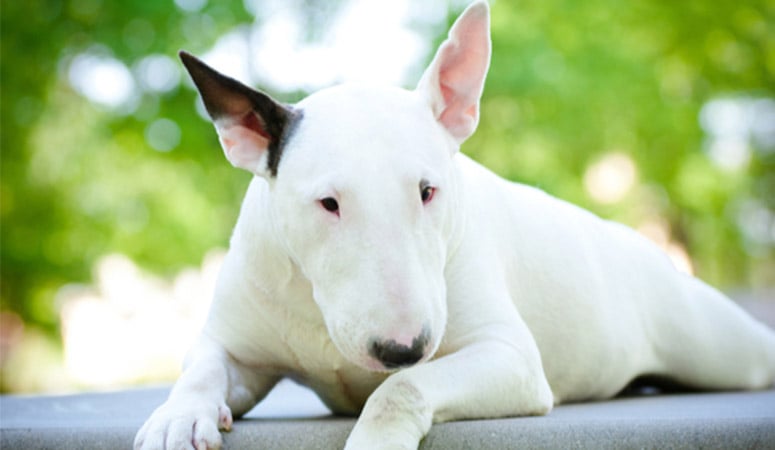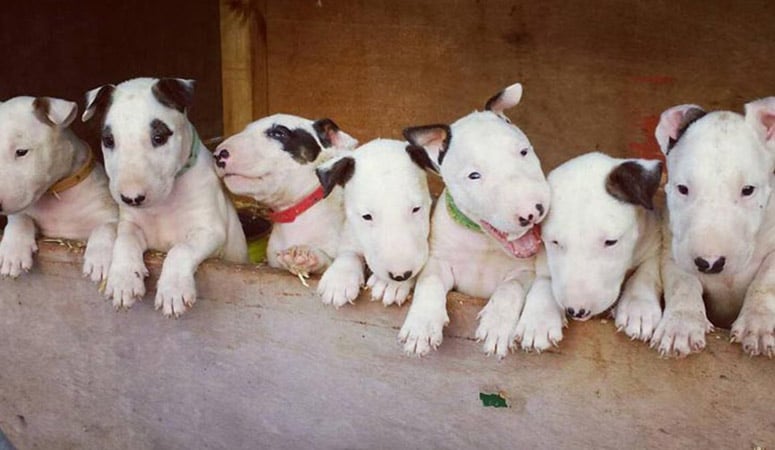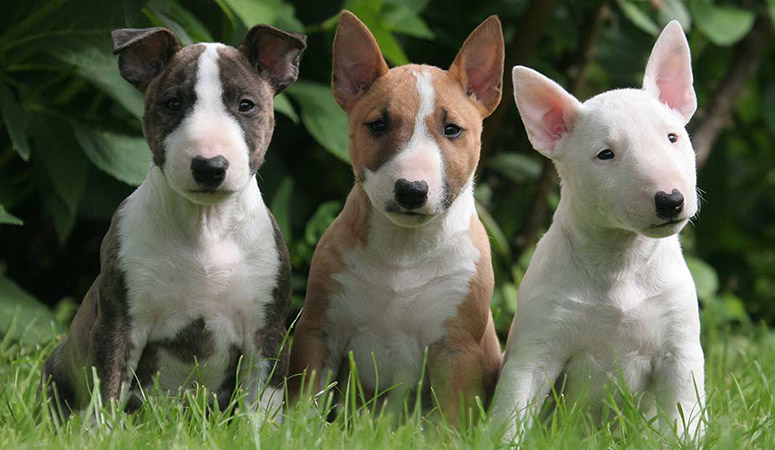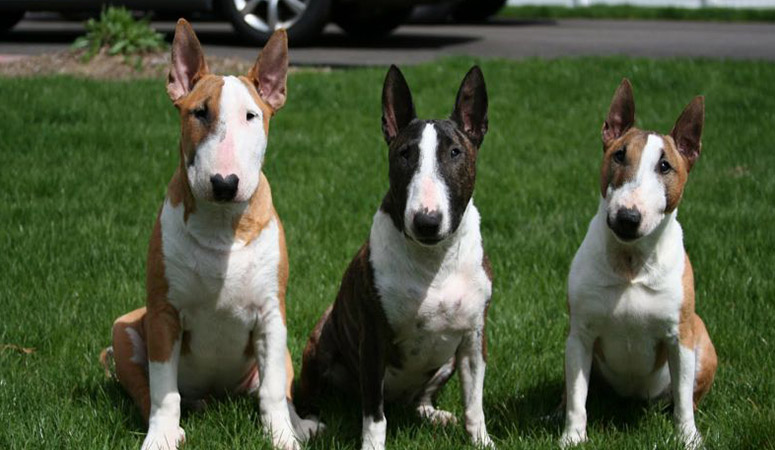Bull Terrier
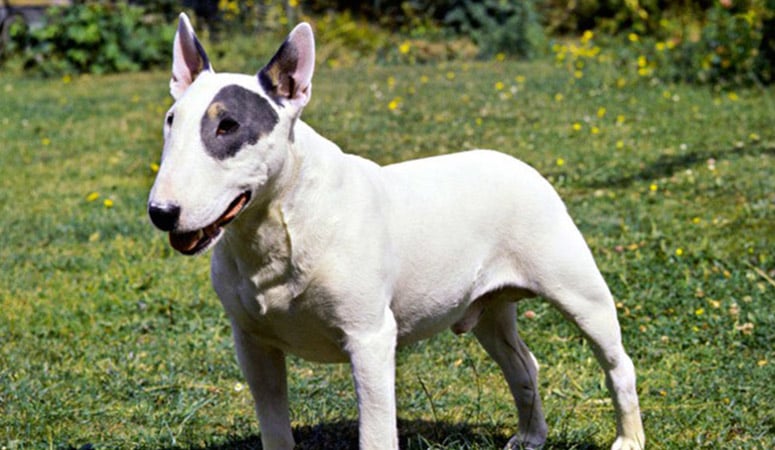
The Bull Terrier is a breed of dog in the terrier family, his unique shape of the egg-like head and robust body makes this breed one of the most recognized in the world. They are friendly, playful, and entertaining, but sometimes are tenacious to push boundaries and bend rules. They are popular as a family pet and consistent training can help them be well-behaved companions.
| Other Names | English Bull Terrier |
| Color | White, brindle, fawn, red, red smut, black, and tricolor (black, red, and white mixture) |
| Height | Males: 20-24 inches. Females: 20-24 inches. |
| Weight | Males: 45-80 pounds. Females: 25-35 pounds. |
| Life Span | 12-13 years |
| Personality | Playful, Charming, Mischievous |
| Exercise | Energetic |
| Origin |
| Popularity | #61 |
| Groom Needs | Weekly |
| Kids Friendly | Yes with supervision |
| Dog Friendly | No |
| Watch Dog | |
| Family Dog | |
| Litter Size | 4-5 |
Bull Terrier Pictures
Bull Terrier Video
Introduction
The Bull Terrier is easily identifiable with its egg-shaped head, muscular body, and rather big bones. A playful and rambunctious dog with remarkable agility, a Bull Terrier brings in joy and laughter and yet can be obstinate on rare occasions. They come in a short, dense coat, the color of which could be either white or any other color, (solid or with white markings).
Grouped under the terrier group by the American Kennel Club, the Bull Terrier is one of America’s favorite family dogs and devoted companion. A standard Bull Terrier stands 21-23 inches from paw to shoulder and weighs between 50 and 70 pounds, depending on the specific dog. A Bull Terrier with its confident stride gives the picture of a valiant warrior. They have an average life expectancy of 11-13 years.
Living with Bull Terrier
The Bull Terriers have a short, flat, harsh, and glossy coat that requires minimal maintenance, they only need weekly brushing with a rubber mitt or curry brush. But during their shedding seasons twice a year, the daily brushing is necessary to keep their hair under control. A bath every three months or when necessary in a mild shampoo is required, as this breed is naturally clean with little doggie odor.
Brush their teeth at least two or three times a week to remove tartar buildup and the accompanying bacteria, and the daily brushing is better to keep fresh breathe and prevent gum disease.
Check their ears to ensure that here’s no debris, redness, or inflammation and gently clean the ears with a dog-friendly cleanser every week or two. Trim their nails about once or twice a month to avoid snags and cracks.
Bull Terriers require half an hour to an hour of moderate exercise every day, which can provide good mental and physical stimulation for them. The daily exercise can be in the form of long walks, chasing a ball, or testing his wits against in interactive toys, besides, they are capable of competing in agility and obedience trials. When taking him to a walk, the owners need to ensure that your dog is on a leash so he won’t chase after other animals or go off exploring himself.
Bull Terrier is developed for sport as well as to be a gentleman’s companion and possesses great strength and agility. Owners can take your dog to participate in canine sports, such as obedience, agility, tracking, coursing ability tests to fire out his energy.
Generally, Bull Terriers need to be fed with two to four cups of high-quality dry dog food every day, divided into two meals. There should be clean fresh water at all times. More importantly, the food amount should vary depending on your dog’s weight, activity level, and age.
Bull Terriers need a good diet that includes natural calcium, especially in their puppyhood. The owners can give your dog a little yogurt or whole milk in the morning and in the evening. Also, you can add some naturally high-calcium food like broccoli to their diet during its rapid growth periods.
Some dogs are easy to get overweight, so you need to watch their calorie consumption and weight level all the time. Treats may be an important aid in training, but excessive intake can lead to obesity. Also, owners need to distinguish which human food is safe for dogs and which are not. If you have any problems with your dog’s weight or diet, just consult from your veterinarian.
Bull Terriers are prone to the following health conditions: familial nephropathy, congenital deafness, heart complication, patellar luxation, hip and elbow dysplasia, skin ailments, especially in the white variety, and allergies…
Major concerns: kidney problems (hereditary neprhitis and renal dysplasia), deafness (in whites)
Minor concerns: compulsive behavior, allergies, heart problems (SAS, mitral stenosis)
Occasionally seen: patellar luxation
Suggested tests:
Cardiac Exam
BAER Testing
Patella Evaluation
Kidney-urine Analysis
Total Annual Cost: $2745
Cost is estimated for the first year and may vary depending on many factors, such as dog food, health care, leash, collar, licensing, possible fencing, crates, training and obedience classes, dog-walking, grooming, treats, toys, flea, tick, and heart-worm meds, microchips, etc.
Bull Terriers are stubborn and brave, as a member of the Terrier Group, this independent free-thinker is highly responsive to “fun and games” than to a work ethic. They will only follow the fun principles, so owners need to make the training fun so that they will excel. Besides, positive reinforcement with food or toys is an excellent place to start.
Learning new skills and lifelong training is good for the energetic Bull Terriers, also, their family is rewarded with a well-behaved dog. Furthermore, they could excel at a variety of canine sports, such as agility, obedience training, flyball, weight pulling, and carting, as well as participating in search and rescue activities, assistance, and therapy dogs.
History
Bull-baiting was a popular sport in old England in the 1400s up to the 1800s when blood sports were outlawed in Britain. The old English Bulldogs, which are now extinct, were famous participants in the bull-baiting, where the dog was let loose upon a staked bull, with a crowd of spectators chanting and betting their money on the outcome of the fights. Around the early part of the 19th century, bull-baiting and its gory happenings were banned in England, although blood sports lovers continued to hold their shows illegally, in pits and empty dams, this time it was rather dogfighting. In this new and unfamiliar sport, the Bulldog proved powerful but rather slow to engage in such a sport that required agility.
This awoke a need to create a breed that could possess the strength of the Bulldog and the agility and animation of the terrier breeds. This started a generation of bulldog and terrier crosses, which initially resulted in dogs known as the bull and terrier types. It was observed that the emergent breed of a dog combined the doggedness of the Bulldog with the agility of the terriers. As there was no standard at that time, the bull and terriers were mainly bred for performance rather than appearance. This led to further crosses, with subsequent breeds diverging from the original ancestors. This divergence created a distinct breed which was later called the Bull Terrier.
James Hinks was credited with the major work of improving the Bull Terrier breed around the 1860s. He had a penchant for white dogs, hence most Bull Terriers of his time were white, although half a century later, colored varieties emerged. The American Kennel Club registered its first Bull Terrier in 1885.
Helpful Information
Breed Club: BULL TERRIER CLUB OF AMERICA
Breed Club Link: https://www.btca.com/
Breed Club Rescue: Bull Terrier Rescue
Breed Club Rescue Link: https://bullterrierclubofamericarescue.com/

